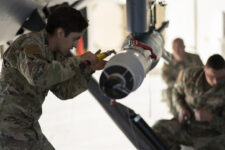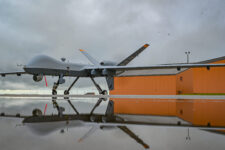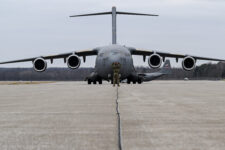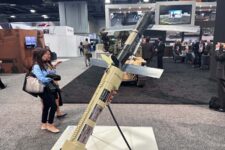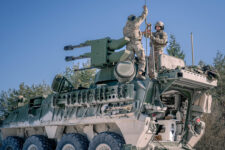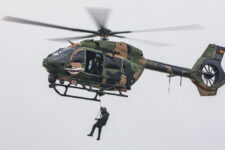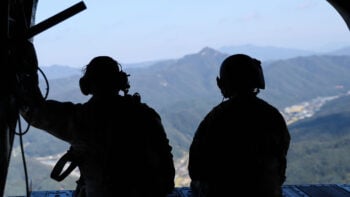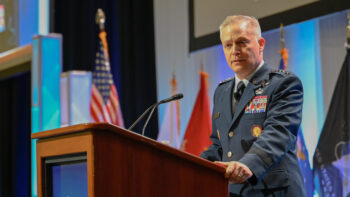
US Air Force artist’s rendering of the Sentinel in flight. (Credit: US Air Force)
WASHINGTON — As costs for the Air Force’s nuclear-tipped Minuteman III ICBM replacement balloon and its schedule slides by as much as two years, service officials today made clear that the LGM-35A Sentinel program will move forward — and that despite budgetary pressure, no alternative is viable.
“We will have to find the money. Sentinel is going to be funded,” Lt. Gen. Rick Moore, Air Force deputy chief of staff for plans and programs, said during a discussion hosted by the Center for Strategic and International Studies. “One way not to solve this is to think that we can just extend Minuteman III. There is not a viable service life extension program that we can foresee for Minuteman III.”
Last week the Air Force notified lawmakers that the Sentinel program’s costs increased by 37 percent, triggering what’s known as a “critical” Nunn-McCurdy breach that requires Defense Secretary Lloyd Austin to certify the program to prevent its cancelation. Officials explained that the rising pricetag — now estimated at almost $132 billion in current dollars — stems not from the missile itself, but mainly the facilities that enable it, like silos and launch centers. The new ICBM is made by Northrop Grumman.
“Some of the assumptions that were made at the beginning of the program, when the initial cost estimates were made, were just not particularly valid,” Kristyn Jones, who is performing the duties of the Air Force under secretary until a nominee is confirmed by the Senate, said during the CSIS panel.
“And now we have a lot more information that should allow us to stay much closer to the cost estimates that will be developed as part of the Nunn-McCurdy process,” she added.
As part of that process, the Office of the Secretary of Defense will conduct a full review of the program to hunt for cost savings and restructure where necessary if the program is to continue. According to Jones, officials already have “extensively” looked for cost savings, and though that work will continue, other changes to elements like the program’s “management structure” could be made.
The rising costs for Sentinel are sure to squeeze a budget that already must fund multiple modernization efforts. Moore said today that the Air Force’s nuclear modernization “bow wave” was previously estimated to peak in 2027, but that now might not happen until 2028 or 2029. That peak could coincide and compete for funding with other major efforts like the Air Force’s Next Generation Air Dominance fighter, a sixth-gen jet the service wants to field by 2030.
“There is a lot of stuff going on in this portfolio. And as they stack up on top of each other, it becomes a daunting task,” he said. “We had hoped to get that peak behind us before the things that we’re working on for research and development right now go into procurement,” he continued, though now it’s “unlikely that that will be the case.”
Jones said it was her “hope” that “throughout the end of this process, we’ll be able to fine tune the program and reduce risk moving forward, that there won’t be a decision made that we can live without it.”
Surging Munitions
Elsewhere during the discussion, Jones and Moore also weighed in on the issue of the defense industrial base, subject of a new Pentagon strategy unveiled this month.
One issue in particular highlighted by Moore is the need to “surge” munitions production, a tough lesson the Pentagon had to learn in the wake of Russia’s invasion of Ukraine. When the DoD turned to suppliers to ramp up output of vital munitions like artillery shells and missiles, years of low investment predicated on efficiency for counterterrorism meant it would take several years to increase capacity. Future conflicts may not provide that luxury for the US, Moore warned.
“It would seem to us that it makes sense that we should be willing to invest in surge capacity that we may not intend to fully procure from,” he reasoned. “If we don’t build it now, it won’t be there when the time comes that we need it. And it seems to us that that’s a pretty good investment.”
Notably, Moore seemed to echo comments made by executives at top defense contractors who have championed greater government spending to surge production. Lockheed Martin Chief Executive Officer Jim Taiclet, for example, has touted a concept of “anti-fragility” in the supply chain, which would translate to measures like more multi-year procurements and even a slightly higher per-unit cost for a given system.
Moore seemed open to those kinds of investments, though he warned his service might be alone in that regard.
“I think the Air Force is maybe a little bit of an island there. That doesn’t seem to play well outside the Air Force,” he said. “But it seems like a pathway to us that could be kind of straight up the middle considering budgetary pressures, but also the need to move rapidly into surge mode in the event that crisis turns into conflict.”
